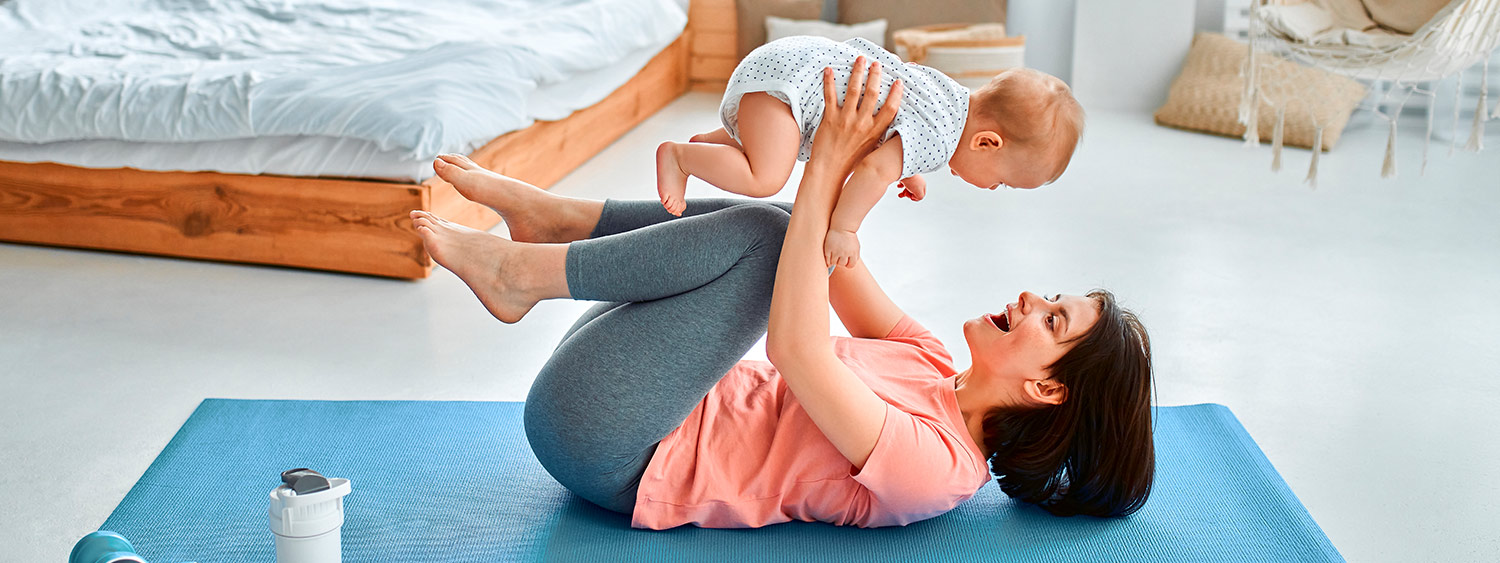
Article at a Glance
Giving birth is one of the most rewarding and challenging moments of your life, but it takes a toll on your body and mind. Seeing all the changes in your body and spending a lot of time at home with a baby can make you impatient to get back into your exercise routine. But when is it safe, what workouts can you do, and how hard should you push yourself?
Here are some tips to help you burn calories, strengthen your body, and recover faster.
According to the Mayo Clinic, if you had a healthy pregnancy and no complications during birth, you could work out within a week after giving birth. However, this doesn’t mean you can jump right into where you left off before you became pregnant. Like stepping into a hot bath, you need to ease into exercise because your body is still in the healing process, which usually takes up to six to eight weeks. Walking with your baby for 10-15 minutes daily is a good start, and you can gradually build up to more time. Too much strain can delay your body’s recovery or put stress on sutures.
Recovering from a C-section or a complicated birth may delay when you can work out again. Be sure to ask your doctor about when it’s safe to lift weights or raise your heart rate with cardio. Once your doctor gives you the okay, take it slow and listen to your body.
Nine months of pregnancy puts stress on your abdominal muscles, which is why core workouts are an excellent place to focus your recover routine. However, you may want to avoid the typical ab exercises like crunches and situps for the first few months after birth. These can do more harm than good while abdominal muscles are still healing. Instead, start with Kegel exercises. Kegels strengthen the core through repeated contracting and relaxing of your pelvic floor muscles.
To perform Kegel exercises, you need to squeeze your muscles as if trying to hold in urine for three seconds and then relax for three seconds. Aim for three sets of 10 to 15 reps a day. Do this workout while breastfeeding your baby, laying in bed, or whenever you can remember to do it.
As you redevelop your core strength, you may want to build up to a larger routine. Additional core exercises may include:
In addition to core workouts, to help reclaim your fitness, there are other safe workouts you can do that will help you regain your energy and feel more like yourself again. Some safe, low-impact exercises include:
After the two months, you may be able to build up to training with weight. Still, try to build up gradually and avoid workouts that put too much strain on your muscles. Focus instead on rebuilding your fitness routine, carving out time for yourself, and recovering your energy. Listen to your body and talk with your doctor about safe points to increase your intensity.
If you’re breastfeeding, you’re burning calories, which could help you lose weight. However, to maintain your milk supply, you need to supplement that energy loss by eating healthy foods.
Balancing a workout schedule with tending to your little one is a challenge every new parent faces. However, you can care for your baby while working out. Here are some suggestions and ideas to blend exercising and quality time with your baby.
Taking care of yourself is just as important as taking care of your newborn, and part of taking care of yourself is to set aside “me-time.” Schedule regular times for dad, grandma, or a sitter to watch your newborn so you can take in some fresh air, a swim, or a visit to the gym. Exercising solo not only helps your body, but also helps rejuvenate your mind for another day parenting a newborn.
Asking for and accepting help may be difficult, but know that it will help reduce some of the stresses that accompany child-rearing. Having some alone time is an essential way to help you rest and recharge.
It’s natural to want to lose all the baby weight as fast as you can, but it’s not realistic to do so just months after giving birth. Each body is different, but in most cases, it takes 6 months to a year to lose baby weight and “feel normal” again. During your journey to reclaim your fitness, set realistic weight loss goals for yourself and continually speak with your doctor about what he or she thinks is safe and beneficial.

As a pediatrician and father of six kids, Dr. Bartholomew has a lot of experience with twins and premature infants. In addition to getting to know his patient families, he enjoys the great outdoors, Dr. Seuss, and BYU football.